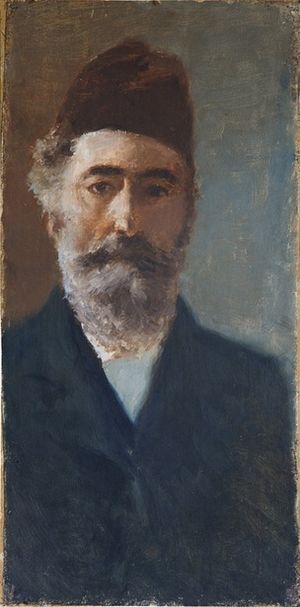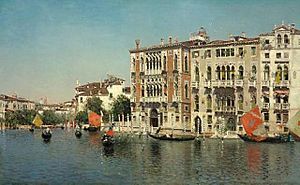Martín Rico facts for kids
Martín Rico y Ortega (born in El Escorial on November 12, 1833 – died in Venice on April 13, 1908) was a Spanish painter. He was famous for his beautiful paintings of natural scenes (landscapes) and city views (cityscapes).
Martín Rico was one of the most important artists in Spain during the second half of the 1800s. People all over the world, especially in France and the United States, knew and loved his work. From his first paintings of the mountains near Madrid to his later works in Paris and Venice, Rico always loved painting outdoors. This way of painting is called en plein air. His artistic style changed over time, but his love for outdoor painting stayed the same.
Contents
Martín Rico's Life and Art Journey
Martín Rico was born in El Escorial, Madrid. He started his art training at the Real Academia de Bellas Artes de San Fernando in Madrid. There, he studied with Jenaro Pérez Villaamil, who was the first professor of landscape painting at the Academy.
Early Influences and Moving to Paris
When Rico first started painting, he was influenced by a style called Romanticism. This was the style his teacher, Pérez Villaamil, was known for. Romanticism in art often shows strong feelings and dramatic scenes.
In 1860, Rico received a special scholarship from the government. This allowed him to move to Paris, France, to continue his art studies.
Once in France, Rico found new inspiration from artists of the Barbizon school. These artists liked to paint nature directly, often outdoors. Charles-François Daubigny was one artist who especially inspired Rico. During this time, Rico painted many landscapes of the French and Swiss countryside. His paintings showed a very realistic style.
Toward the end of 1870, there was a lot of political trouble and social unrest in France. This was because of the Franco-Prussian War. Because of this, Rico decided to leave France and go back to Spain.
Painting in Southern Spain
When Rico returned to Spain, his good friend and fellow painter, Marià Fortuny, invited him to Granada. Rico joined Fortuny, Fortuny's wife Cecilia, and another painter named Ricardo de Madrazo.
The three artists worked very closely together during this time. Rico and Fortuny's painting styles became so similar that their watercolor paintings were often hard to tell apart! Watercolors were a special skill for both artists. During this period, Fortuny's influence helped Rico's paintings become brighter and more colorful. Rico later wrote in his memories that his time in Andalucía (southern Spain) was one of his happiest and most productive periods for art.
Discovering Venice: A New Artistic Home
In 1873, Rico visited Venice, Italy, for the first time. This trip was very important for his art. It helped him make his artistic style even better and create some of his most famous works.
Rico and Fortuny traveled to Italy together that year. They visited Rome, Naples, Florence, and Venice. Of all these cities, Venice truly captured Rico's artistic imagination. From that first trip until he died 36 years later, Rico spent almost every summer working in Venice. He called it the "City of Light."
Venice is a unique city with its plazas, churches, and canals. Its special light also attracted many other famous artists. These included Édouard Manet, Claude Monet, John Singer Sargent, Pierre Renoir, and Federico del Campo.
Rico joined this group of artists. He also followed an old tradition of Italian painting called vedute, which means "views." He often painted his Venetian scenes outdoors, sometimes from a gondola (a type of boat) in a canal. Other times, he painted from the window of his room in the Dorsoduro neighborhood. Rico became good friends with the Peruvian painter Federico del Campo. Sometimes, the two artists worked together, painting the Venetian scenes that were very popular with tourists visiting the city.
Martín Rico died in Venice when he was 74 years old.
See also
 In Spanish: Martín Rico para niños
In Spanish: Martín Rico para niños




